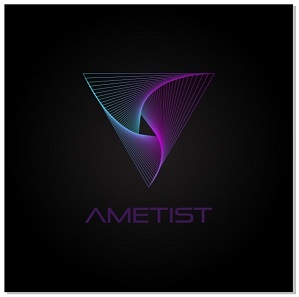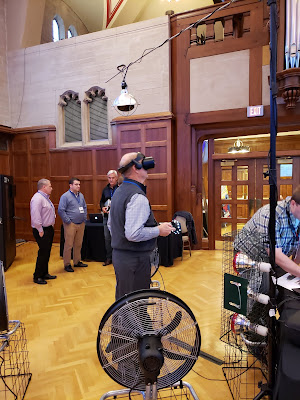Monday, December 9, 2019
Playing with Photogrammetry
Thursday, October 17, 2019
THE CAAV - Day #3
The shortest day, only in the morning.
Day 3 started with one of the developers of XR content for Microsoft Hololens and Oculus Rift.
Followed by a panel where the audience reported their own successes and failures when working with alliances with other institutions
One interesting presentation was from a from student at IU that's now part of the permanent staff at AVL there. He showed us his experience developing 4D VR demos, particularly a hot air balloon ride with hot lamps and fans around the user to enhance the experience (I posted picture of this experiment yesterday
And that's all from Bloomington, Indiana. Despite all the interesting presentations and demonstrations that I attended, I would argue that the most important outcome of this while experience was the various contacts with faculty and researchers of the field of virtual and augmented reality and visualization.
This might be an important step towards partnerships in national or even international projects. Time will tell!
Wednesday, October 16, 2019
THE CAAV - Day #2
Second day of the event started with us being reminded that serious games should first and foremost be playful (usually developers are always too concerned with the pedagogical aspects that they forget the ludic facet of such applications).
Then we learned about initiatives that are using VR as a means to attract people back to traditional libraries. The one presentation I liked the most discussed brain-computer interfaces (BCI) and the upcoming event of BCI Game Jam.
Then, a panel of specialists discussed trans-disciplinary collaborations followed by a presentation that discussed the creation of collaborative virtual environments where multiple users can interact in the same environment each one wearing its own VR gear.
During every break we get to try first-person on several applications developed by students and researchers presenting at the CAAV
We learned about the experience of our host the Indiana University regarding their virtual reality laboratory called Advanced Visualization Lab (AVL)
Another interesting presentation was on "Virtual Archeology" that explained that one characteristic of that field is that it is destructive, meaning that a dig can only be explored once before all be gone forever. By using VR its possible for a professor to explore the same scenario multiple times, for a fraction of the cost that bringing students to a remote location cost.
The day ended with a presentation of the sponsor where it was discussed the new technologies available for visualizing VR content, followed by the social event of the conference: bowling & billiards
Tuesday, October 15, 2019
THE CAAV - day #1
Hello all,
Today was day 1 of The CAAV - The Campus Alliance for Advanced Visualization) (https://rt.iu.edu/thecaav19/index.html) in Bloomington, IN.
In summary, I attended a series of presentations of several subjects involving virtual (and augmented) reality, applications, a discussion panel about hardware & software for VR/AR. Also, several demonstrations of applications of VR/AR developed by researchers and students from different universities.
Here some consideration I drew after pondering about what I heard, saw and discussed today:
- Regarding modeling solutions the following technologies have been mentioned:
- Autodesk Revit
- Blender
- Autodesk Maya
- Autodesk 3DS Max
- Conduit
- Regarding game engines:
- Unity (almost the totality of the projects mentioned it)
- CryEngine
- Regarding augmented reality solutions:
- AR toolkit (the majority)
- Vuforia (mentioned several times)
- Other considerations:
- Many universities mentioned that the fact they don't have a specific VR/Games program significantly impairs them on researching the field
- General opinion regarding Unreal Engine vs Unity: UE is specific to games, Unity is general-purpose. Also, Unity is much less demanding in terms of computation demands = in conclusion: choose Unity
Below some pictures of the event and the demonstrations
Thursday, September 26, 2019
ICPC previous sessions
Week #1 - Introduction
Week #2 - Combinatorics
Week #3 - Strings
Motion Capture Lab @UHV is once more a reality!
Motion capture (sometimes referred as mo-cap or mocap, for short) is the process of recording the movement of objects or people. It uses special infrared cameras to track optical markers placed onto a subject's body wearing a suit. The spatial position of each marker is captured in real-time producing a massive amount of data that can later (after processing) be used in a large variety of applications like character animations, visual effects, motion analysis and much more.
Our own mocap solution contains 24 of such cameras that are now operational allowing us to use the installations for whatever we need: gaming, animations, computer science, kinesiology, etc. Check it out below some pictures we took during our training sessions.
Its time for us to start learning, practicing and developing our first test applications with this technology. If you are a UHV student interested in volunteering to help us work with one of our ongoing demo projects, please contact Dr. Rogerio da Silva at dasilvar@uhv.edu or come by his office at UW 254.
Soon enough the AMETIST group will be ready to invite everybody interested in learning more about this exciting domain.
Friday, September 13, 2019
ICPC training sessions kick off
After months of preparation and a new laboratory being sorted specifically for the task... yesterday we had our first ICPC training session at UHV room UC201A + ZOOM meeting.
ICPC is the International Collegiate Programming Contest. The single most prestigious programming competition worldwide. Teams of three students sharing a computer trying to solve the most problems in 5 hours.
It involves problems in several domains: algorithms and programming fundamentals, data structures, strings, searching & sorting, number theory, combinatorics, computational geometry, grids, dynamic programming, backtracking, arithmetic & algebra, and graphs.
The goal of our weekly training sessions is to foment students to improve themselves in terms of programming, so to form teams to participate in the actual competition that takes place every November.
If you are a student at UHV (from any major) wanting to improve your own programming skills, even if you can't or doesn't want to compete, just to program, come join us!
Our training sessions take place every Thursday starting 2PM at room UC 201A in Victoria campus or online via Zoom.
Thursday, August 15, 2019
Introducing AMETIST...
Professor Rogerio Eduardo da Silva is taking the lead of the group and plans to have many students (and even other faculties) involved in studying and developing possible applications of technologies used to produce games for many other fields of knowledge like virtual/augmented reality, robotics, motion capture, computer vision and tracking, gesture/posture/voice/face recognition, 3D modeling and printing, interactive digital storytelling, artificial intelligence, programming, and so much more!
If you are a student at UHV of any major (CS, DGS, Biology, Creative Writing, Communications, Education, Health care, ...) at any level (from Freshman to Senior or even Master) and is interested in visiting us to learn about what we are planning to do and even want to take part as a volunteer, just contact us and come by my office (room UW254) or our lab. (UW 224).
I'm sure we can find some activity/project for you!






















